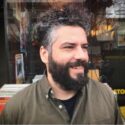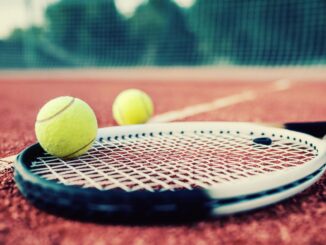
The Australian Open is by lengths my favorite of the four tennis majors. Perhaps it’s the blistering, sun-baked court in the middle of our winter that enamors me, or the fact that, in the heart of the dark night, I can tune into a meaningful sports event when I am unable to sleep.
In fact, the persistent rhythm of the ball repeatedly crossing over the net, the tracking of my eyes, has helped me get to sleep on more than one occasion. There’s something soothing about it, knowing that halfway around the world people are awake, enjoying a lager, whiling away the day, lazing in the sun.
I also love how the American sports world, for once, focuses in on the Land Down Under. Australia has a lot to offer when it comes to sport. Aussie Rules Football. Rugby. Cricket. The Australian Basketball League. And yet, it seems the only time American eyes are really interested in what goes on in Australia is when the masters of racket and ball descend for a fortnight to the extreme heat of Melbourne in the hopes of bringing home the Daphne Akhurst Memorial Cup, or the Norman Brooks Challenge Cup, respectively.
This year’s Australian Open has been no exception, in terms of intrigue and allure. Martina Navratilova and John McEnroe held an on-court protest following the celebration of the 50th anniversary of Margaret Court’s grand slam. Court, of course, has the most grand slam trophies of any tennis player, but her life after tennis has consisted of one raging, homophobic comment after another. You can read about the protest, and link to Court’s unconscionable views, here.
Meanwhile, the devastating bushfires in Australia left some question at the outset of the tournament whether or not the Australian Open would (or should) even take place. Players protested the forced continuation of qualifying matches in unplayable air quality. Many people believed it was unethical to hold a tennis tournament in Australia when literally millions of animals are dead and thousands of people are displaced.
The tournament did begin, however, and players have been rallying to garner aid, and help meet the gigantic need for bushfire relief. You can read about that here.
External events aside, it’s no surprise that some amazing tennis has been going on! Roger Federer staved off seven match points (yes, seven) in the quarterfinals against the aptly named American Tennys Sandgren (who produced his best major performance to date). Fifteen-year-old phenom Coco Gauff had another stupendous and inspiring run, eliminating both Venus Williams and defending champion Naomi Osaka, only to lose to the less-heralded, though 15th ranked, American Sofia Kenin.
Kenin subsequently knocked off Australian national and number one ranked Ashleigh Barty (perhaps the weight of an entire nation was too much?), and Kenin will now face off against the rejuvenated and frighteningly talented Garbiñe Muguruza in the final this weekend.
Federer, unfortunately, suffered physically despite surviving Sandgren’s challenge, and succumbed easily to Djokovic in the semifinals. Djokovic, meanwhile, will now look to improve to 8-0 in Australian Open Finals, joining Federer (8 Wimbledon) and Nadal (12 French) as the only tennis players in history to win an individual major eight times.
Needless to say, the drama has been ripe, and anyone who has managed to stay awake into the wee hours for a dose of hardcourt action has been duly rewarded.
Nevertheless, it’s hard to stay awake.
For those of us on the West Coast, the matches with the most appeal often begin at 12:30am. 12:30am! How does one do it?
Let me offer a suggestion.
About six months ago a friend (who reads my book review sports column regularly) suggested I pick up Álvaro Enrigue’s 2013 novel Sudden Death. “It would be perfect!” he wrote. So, like a good friend, I checked it out from the local library, and then waited for the perfect time to read it.
And let me tell you, the Australian Open is the perfect time.
Sudden Death begins with the line “The oldest written record of the word tennis makes no mention of athletic shoes; rather, it refers solely to the sport from which they take their name, a sport that – along with fencing, its near kin – was one of the first to require a special kind of footwear.” One gets a sense of Enrigue’s peculiar interests from the outset.
While Sudden Death is hardly solely about tennis, it uses an imagined tennis match between Caravaggio (the revered Renaissance painter) and the Spanish poet / nobleman Francisco de Quevedo as its foil. In late 1500’s Italy the game is referred to as pallacorda (literally: ball game), and pallacroda is generally considered the precursor from which our modern version of tennis has sprung.
In fact, one of the most noteworthy aspects of Sudden Death is the extent to which Enrigue unearths documents from the Renaissance (and before and beyond) that mention tennis, that describe or refer to the game in some way. At times, the novel feels documentary, as if we are with Enrigue in the archives, simply viewing what he finds.
While the novel is filtered through the imagined tennis match (and the drama that led to it), the intervening chapters take up Spain’s ruthless and bloody conquest of the New World (Hernán Cortés is one of the novel’s main characters), Mexico’s national identity (Enrigue is Mexican), the process of writing the book, a remarkably detailed investigation into the ancient art of making tennis balls (the balls used in the match between Caravaggio and de Quevedo are stuffed with the hair of the beheaded Anne Boleyn), and the intricacies of Renaissance politics, specifically among the papacy, among other things.
What is remarkable, however, and specific to this column, is how intricately Enrigue is able to relay the ups and downs of the pallacorda match, and the history of tennis itself, to his readers. The minute detail involved in his imagining of a 16th century street match makes one feel as if Enrigue, and subsequently his readers, actually witnessed it. One likewise gets a real sense of the history of the sport, how vital tennis was at this time to those who partook in it (it is Caravaggio’s and de Quevedo’s way of settling a duel, after all), and the important place tennis held in early modern royal courts. We see this tradition continued today, no doubt, in the annual pomp and circumstance that surrounds Wimbledon.
Fascinatingly, the novel culminates in the suggestion that Caravaggio’s ability to see light, his game-changing use of chiaroscuro (that literally defied all art that came before him and influenced all art that came after him) was made possible, and actualized, when Caravaggio happened upon a miter (a tall headdress worn by bishops) made by a “Nahua of noble birth and master featherworker” from the New World, brought to Caravaggio’s patron’s office (in a complicated route that Enrigue traces astutely).
Caravaggio literally falls into a stupor: “Whoever made this, he thought, can read God’s design.”
Enrigue, beautifully, implies that the most important revelation of Renaissance art from its most important painter was, essentially, old hat among indigenous peoples of the New World. This re-envisioning is powerful, and crafted so intricately, so wildly, and yet so pointedly, that on the novel’s close, one is tempted to simply start reading it again, to try and understand how Enrigue pulled this off.
The novel received (deservedly so) a handful of prestigious awards in the Spanish speaking world (published originally in Spanish in 2013; translated expertly into English in 2016 by Natasha Wimmer). And while the novel is brief enough to attract and maintain interest in a casual reader who happens to pick it up, for those into tennis (not to mention re-imagined” Europe meets New World” history), the book will unquestionably hold a memorable, lasting, and entirely unique place. It’s safe to say (despite Enrigue’s influences, which are easy to trace), there’s nothing quite like it.
So if you are in need of something to do these weekend nights, and don’t feel like taking No-Doz to combat the 12:30am start times of the women’s and men’s Australian Open Finals, find Enrigue’s book and get it on your shelf. You will think about tennis, and a great deal of other subjects, more than you ever cared to.




